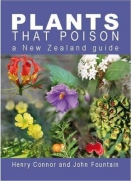|
The following list of was supplied
by the New Zealand Ministry of Education and is part of a resource
published by the Ministry of Health: Nga kupu Oranga, Healthy
Messages, A health and safety resource for early childhood services.
Some of the names have
been corrected on this page. Links from the plant names are to images
and descriptions reproduced with permission from Common
Weeds of New Zealand.
- Apple
of Sodom (Solanum
linnaeanum Hepper & P.-M. Jaeger)
Poisonous parts: The berries
- Apricot
(Prunus armeniaca L.)
Poisonous parts: The kernels inside the fruit stone.
However, they are not poisonous once they have been cooked
- Arum
(Arum spp.)
Poisonous parts: All parts
- Bittersweet
(Solanum dulcamara L.)
Poisonous parts: All parts, especially the berries
- Boxthorn
(Lycium
ferocissimum Miers)
Poisonous parts: Berries
- Buttercup
(Celery-leaved) (Ranunculus sceleratus L.)
Poisonous parts: Leaves and flowers
- Calico
bush (Kalmia latifolia L.)
Poisonous parts: All parts
- Cape
tulip (Homeria collina (Thunb.) Vent.)
Poisonous parts: All parts are very poisonous, even
when they are dead and dry
- Castor
oil plant (Ricinus communis L.)
Poisonous parts: Seeds
- Daphne
(Daphne spp.)
Poisonous parts: All parts
- Elephant
ear (Alocasia brisbanensis (F.M.Bailey) Domin.)
Poisonous parts: Flowers, leaves and stems
- English
yew (Taxus baccata L.)
Poisonous parts: The brown seed inside each berry
- Foxglove
(Digitalis purpurea L.)
Poisonous parts: Leaves and seeds
- Hemlock
(Conium maculatum L.)
Poisonous parts: All parts are very poisonous, even
when they are dead and dry
- Henbane
(Hyoscyamus niger L.)
Poisonous parts: Seed and fruit
- Holly
(Ilex aquifolium L.)
Poisonous parts: Berries
- Horse
chestnut (Aesculus hippocastanum L.)
Poisonous parts: Seeds
- Inkweed
(Phytolacca octandra L.)
Poisonous parts: Berries, leaves and root
- Ivy
(Hedera helix L.)
Poisonous parts: The fruit of some plants. People with
sensitive skins may also develop a rash after touching the plant
- Ivy,
Poison (Rhus radicans L.)
Poisonous parts: The climbing plant is very poisonous
when touched. The shrub may also cause a rash and swelling if
it is touched by people with sensitive skin
- Jerusalem
Cherry (Solanum pseudocapsicum L.)
Poisonous parts: All parts, particularly the berries
- Karaka
(Corynocarpus laevigatus J.R.Forst. & G.Forst.)
Poisonous parts: The kernels of the fruit
- Kowhai
(Sophora microphylla Aiton)
Poisonous parts: All parts, but mainly the seeds
- Laburnum
(Laburnum anagyroides Medik.)
Poisonous parts: All parts, especially the seeds
- Lantana
(Lantana carmara L.)
Poisonous parts: The fruit
- Lily-of-the-Valley
(Convallaria majalis L.)
Poisonous parts: All parts, especially the seeds
- Milkweed
(Euphorbia peplus L.)
Poisonous parts: The fruit and leaves
- Ngaio
(Myoporum laetum G.Forst.)
Poisonous parts: The fruit, leaves and any other green
parts
- Nightshade,
Black (Solanum nigrum L.)
Poisonous parts: The leaves and green berries
- Nightshade,
Deadly (Atropa bella-donna L.)
Poisonous parts: All parts are very poisonous
- Oleander
(Nerium oleander L.)
Poisonous parts: All parts, especially the leaves and
flowers
- Onga-onga
or Tree Nettle (Urtica ferox G.Forst.)
Poisonous parts: The fine white stinging hairs are
violently and can cause death if badly stung
- Peach
(Prunus persica (L.) Batsch)
Poisonous parts: The raw pip that is found inside the
fruit stone
- Poppy
(Papaver spp.)
Includes Iceland, Shirley and Oriental poppies
Poisonous parts: The unripe seeds
- Poroporo
(Solanum aviculare G.Forst.)
Poisonous parts: The leaves and green berries
- Potato
(Solanum tuberosum L.)
Poisonous parts: Green potatoes and the berries
- Privet
(Ligustrum vulgare L.)
Poisonous parts: The leaves and fruit
- Queen
of the Night (Cestrum nocturnum L.)
Poisonous parts: All parts
- Rangiora
(Brachyglottis repanda J.R.Forst. & G.Forst.)
Poisonous parts: All parts, especially the flowers
and sap
- Rhododendron
(Rhododendron spp.)
Poisonous parts: All parts
- Spindle
Tree (Euonymus
europaeus L.)
Poisonous parts: The fruit and leaves
- Thornapple
or Jimsons Weed (Datura stramonium L.)
Poisonous parts: All parts, except the soft, black
petals
- White
Cedar (Melia azedarach L.)
Poisonous parts: The fruit
Web-notes:
Poisonous Plant Links
|
|
|
|
|
Poisonous
Plants Poster depicting some of the more common poisonous
plants within New Zealand. (Out of print).
|
| |
Further
information and lists on Poisonous Plants in New Zealand
are available from Landcare Research, including:
- Plants in New Zealand
Poisonous to Children, also
available here

(this pamphlet replaces the separate lists for the North and South
Islands).
- Safety in pre-school
centres: plants to avoid, also available
here


|
To
contact the New Zealand National Poisons Centre:
0800 POISON /
0800 764 766 — for poisons advice 24 hours a day seven
days a week.
(03) 479 7248 - for all other enquiries between 9am and 5pm
week days.
(03) 477 0509 — facsimile.
E-mail — poisons@otago.ac.nz
Websites:
- The TOXINZ Poisons Information database, developed at the University of Otago, today contains more than 190,000 documents with comprehensive and up-to-date information on poisonous chemicals, pharmaceuticals, plants and animals.
If there are serious
symptoms of poisoning, treat as an emergency and dial 111
for an ambulance.
|
Cornell
University Plants Poisonous to Livestock and other Animals
This is a growing reference
that includes plant images, pictures of affected animals and presentations
concerning the botany, chemistry, toxicology, diagnosis and prevention
of poisoning of animals by plants and other natural flora (fungi,
etc.).
|



